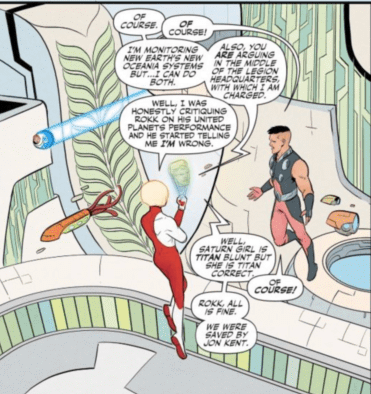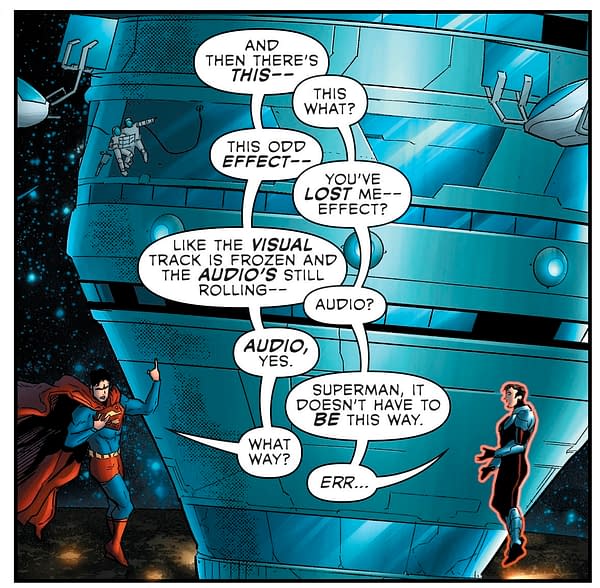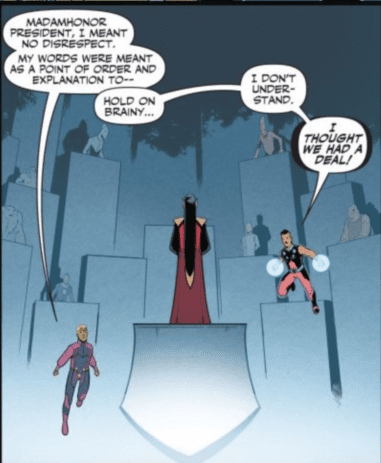On July 28, DC Comics released Legion of Superheroes #7, continuing with writer Brian Michael Bendis’s reimagining of the icon superhero team. Artist Ryan Sook is joined by Wade von Grawbadger (for page 1) and Stephen Byrne, who does the art for pages 2-22. Jordie Bellaire works colors, while Dave Sharpe serves as letterer.
Writing
If you bought this issue thinking it would be about the Legion getting arrested by the United Planets, given the fact that they were previously detained by the police, and this issue begins with them confronting President Brande and the United Planets assembly, I‘d understand your confusion. You would, however, be wrong.
Instead, this issue revives a very old Legion tradition…arguing over who the leader is and holding an election about it. I’m sure longtime Legion fans will appreciate this nod to the Legion’s history, although if you are a person who gets annoyed with comics where people sit around talking the whole time, then this issue isn’t for you.
As someone who has enjoyed Bendis’s work on the whole, I have to say some of his dialogue has been a bit “extra” lately. Reading the dialogue in Young Justice can be a bit of a chore, and while it’s a little better here, the dialogue can be a little “jumpy” and frenetic.
Oh? Were you wondering about the “arrest” thing? That’s just Ultra Boy’s father, the leader of Rimbor, showing up at the end to arrest the Legion. We’ll see how that goes, what with Rimbor leaving the United Planets and Ultra Boy getting elected as the leader of the Legion.
Art & Colors
I know sometimes a change in artist can wreck the tone of the book and take readers out of the story. While I’m sure some people will miss Ryan Sook being the main artist of this book, Byrne does a fine job. Aside from his faces looking a bit more rounded at times (I wanted to say “slightly lumpy,” but I’m afraid that will convey the wrong idea), with Bellaire still doing colors, it still looks like the same book. Byrne’s line work is solid, and Bellaire’s colors make this book a joy to read, even if a huge chunk of it is dedicated to the inner politics of the Legion and its relationship with the United Planets.
The art team should be commended for their attention to detail with each character. This isn’t like a Justice League or Avengers book, with maybe seven characters tops. The Legion is vast, and it would be easy to skimp on details for each character, but each character design pops on the page.

It would be easy to cheat and skip some details of character designs of people in the background, but the art team avoids that temptation.
Lettering
I’ve already noted some of my issues with Bendis’s dialogue of late, and as I pointed out, some of the dialogue bounces back and forth in ways that are slightly confusing.

I understand the dynamic that Bendis and Sharpe are going for here, and on the whole, I appreciate Bendis’s quippy dialogue, but this issue flirts dangerously with Grant Morrison’s satire of such dialogue in The Green Lantern.

This awkward pacing and positioning of dialogue can further be seen when Cosmic Boy and Brainiac 5 have a bit of a squabble over leadership (at least I think that’s what’s going on) in front of the United Planets.

I’m just a bit confused about the pacing of Cosmic Boy’s comments. It reads a bit too close to that Green Lantern panel.
Conclusion
I know I’ve been a bit critical of Bendis and company in this review, but I don’t want that to create a misunderstanding. I like this book, and I’m rooting for it! I think Bendis is doing some cool things in this book reimagining DC’s future. I’m not even saying that I don’t like books that consist more of character interactions than flashy action sequences. I just think he needs to reign in his dialogue a little bit. I’m still excited to see what he has in store for the future of this title, and I hope this book stays with us for a long time!
What do you think of Bendis’s work on The Legion of Superheroes so far? Are you excited? Nervous? Tell us in the comments below!

